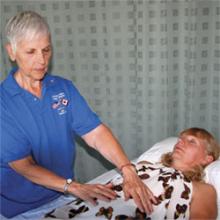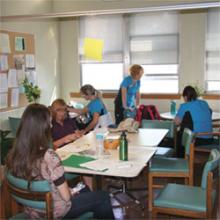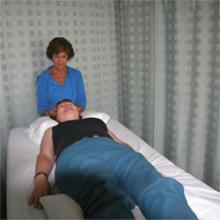by Michael Allen
The concept of the Rainbow Room for Winnipeg’s Health Sciences Centre was originated by Jonathon Ellerby, PhD in 2001. The purpose of this special place is quite simple. Hospital staff work under prolonged stressful conditions, and it was felt that they needed an opportunity to relax and de-stress during their workday. The Rainbow Room provides a calming environment, a relaxing space and relaxation services.
 Cecile giving Reiki to Debbie. During low activity times the volunteer staff often give each other sessions.
Cecile giving Reiki to Debbie. During low activity times the volunteer staff often give each other sessions.Reiki is definitely the most common healing and stress-reducing modality offered in the Rainbow Room. Other modalities currently offered include Healing Touch, Reflexology, Quantum Touch, Remedial and Relaxation Massage, Far-infrared Dome and Chi Machine, Brennan Healing Science, and others, depending on the volunteer practitioners. Hospital staff come over during their scheduled work breaks. The individual treatment sessions typically run from 15 to 20 minutes. The program runs on Tuesdays from 11 AM to 3 PM and Thursdays from 11 AM to 4 PM for massage therapy. There is one rule we want everyone to follow while in the Rainbow Room: speak only in soft whispers.
Relaxation sessions are offered on a first come, first served basis. Staff must sign in (first names only) and indicate the hospital department where they work. They can choose a particular treatment modality depending on whether or not there is an available practitioner for that modality that day. A list of available treatments is always placed by the sign-in board.
Most people who enter the Rainbow Room notice the peace and tranquility immediately. Although this large room is in the hospital’s Isabel M. Stewart Building, which is an external building, the feeling that you are in a large hospital is gone. It feels like a sanctuary. Pleasant hemi-sync music and other relaxing music greets the visitor. There is no hospital public address system in the room. The staff waiting area consists of new sofas and sofa chairs where they can relax, have purified water or a pleasant non-caffeinated herbal tea. In addition to other reading material, a book describing the profile of each practitioner is placed on the coffee table.Repeat clientele usually outnumber new clientele on any given day. I have treated many clients multiple times over the four years I have been with the program. It is impossible not to gain a certain degree of familiarity with client personalities and their ailments and/or stresses. However, information that is passed along to the practitioner is always kept in confidence. For myself, I can sense changes that happen in people through the Reiki healing process. Occasionally I get questions from my clients such as “How is my heart doing?” or “Do you sense any deterioration in my lungs?” or “Can Reiki cure me of a bad habit?” and so on. Of course we have to be diplomatic and state quite factually that we can not diagnose any condition a client might have and that Reiki can not be considered as a “curative treatment” in any medical sense. I always refer them to their doctor. For many clients the Rainbow Room is a place to simply relax during an otherwise hectic day. Only hospital staff are treated. Patients are not.
There is also a traveling Rainbow Room which has been set up to bring a practitioner to one of the wards. The ward must first sign up for the service. Ward staff who find it impossible to get away can sign up for a scheduled treatment. A room is available for the practitioner. I have shared storage space rooms with every type of portable hospital equipment there is. Grounding the extremely dense energies in these places is the first order of priority before the sessions begin. The frenetic pace of a busy surgery ward is an eye-opener to the never-ending demands on hospital staff. Invariably, each ward client is most complimentary after each session for having the few moments of total relaxation given to them.The Rainbow Room provides a wonderful opportunity for a Reiki practitioner such as myself to get many hours of treatment experience throughout the year. Many Rainbow Room practitioners are retired nurses who have gone on to learn one or more healing modalities. They know only too well what incessant demands are placed on hospital staff each day, especially on days when an extra shift has been added to the “normal” schedule. Practitioners have an opportunity to build skills, staff receive the emotional and physical benefits of relaxation, and hospital patients benefit from the care of staff who return from breaks refreshed.
This article appeared in the Winter 2009 issue of Reiki News Magazine.









